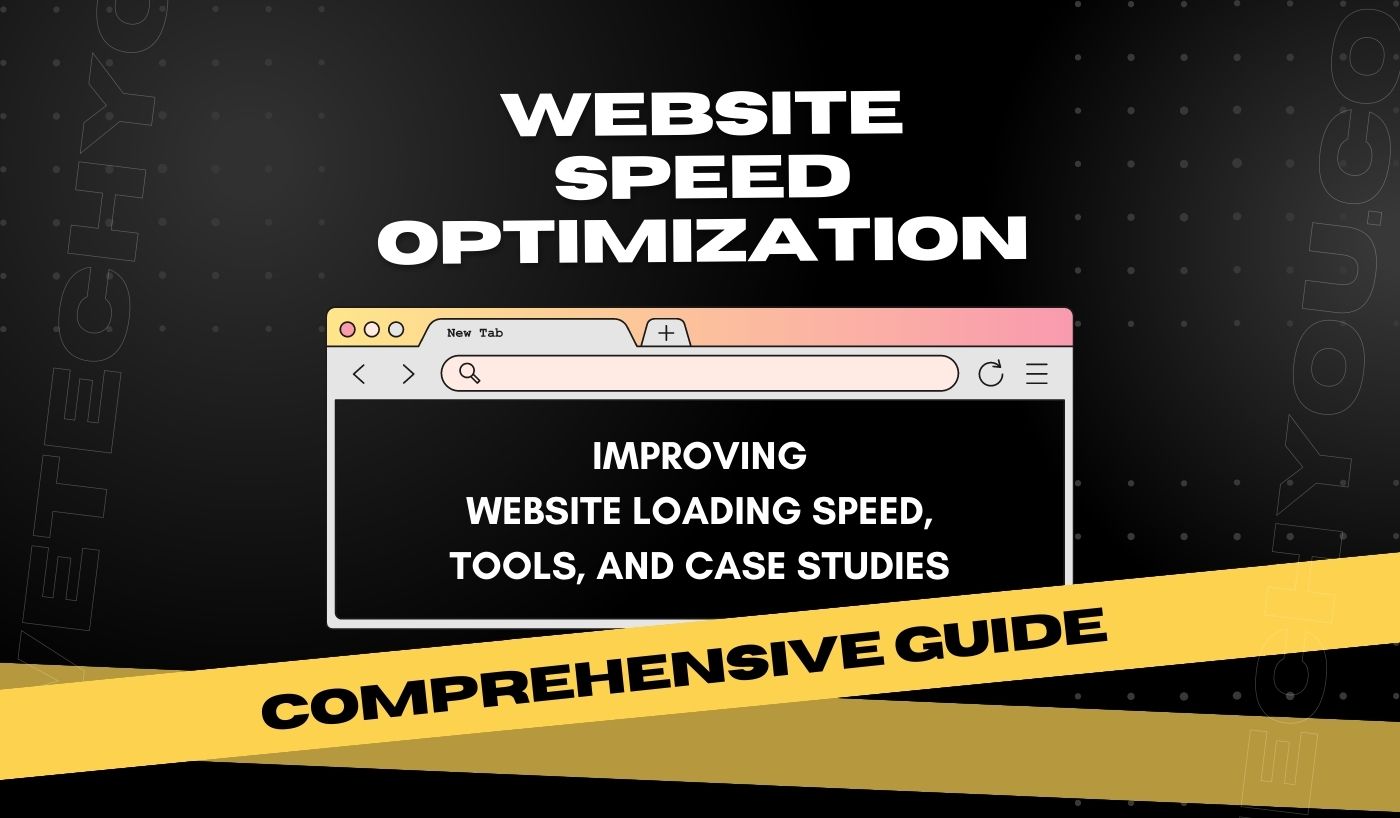Everything in today’s digital world boils down to speed. It makes no difference if you have the most complicated and visually appealing website if it takes a long time to load. There are various reasons why your online pages may load slowly. However, regardless of the cause, you’ll learn valuable strategies and tactics in this guide. These tactics will help to improve your website performance and speed, ensuring a pleasant user experience today.
But first and foremost, what is the importance of page speed? According to research, the time a user will wait before losing concentration ranges between 0.3 and 3 seconds. If it takes longer than your website to display vital information, the user may lose concentration and even exit the browser window. Websites that load faster have fewer bounce rates, higher conversion rates, higher organic search rankings, and an overall better user experience.
In short, slow websites cost money and damage your brand. Making your web pages load faster, on the other hand, will increase traffic, user retention, and sales.
Understanding Website Speed Optimization
1. What Exactly is Website Performance Optimization?
Website speed optimization refers to tactics and best practices to make a website as fast as possible. Other advantages to website performance optimization include an increased conversion rate, a decrease in bounce rate, and an improved user experience.
Studies have shown that website speed is related to other key metrics. According to research by Portent, a B2B site loading in 1 second has a three-times greater conversion rate than a site that loads in 5 seconds.
Every subsequent second of load time amplifies the difference in conversion rates. The average conversion rate is 39% when pages load in one second. After two seconds, this rate lowers to 34% and 22% for a five-second load time. After that, your conversion rate can be expected to be approximately half that of websites with lightning-fast loading times. Below is a graph depicting the effects of website speed on the total goal conversion rate.
What Influences Site Speed?
There might be several reasons why your site’s load time is slow. Some reasons are listed below:
- Heavy CSS and JavaScript use
- Hotlinking images
- Resources from slow servers
- Large image sizes
- Not using browser cache
- Older browsers
- Poor server/hosting plan
- Slow network connection (mobile devices)
- Too many widgets and plugins
- Traffic volume
That means the most prevalent causes are various methods you can take to improve page performance. However, you should evaluate your page load time before troubleshooting to increase website speed.
What is an Optimal Website Speed?
According to research, the time a user will wait before losing concentration ranges between 0.3 and 3 seconds. That implies you should try to show some content to the user in less than 3 seconds.
If you elect to use the Core Web Vitals metrics described above, the following are the suggested thresholds to aim for:
- In the largest Contentful Paint, ≤2500ms is a good speed, and >4000ms is considered a poor speed.
- In the First Input Delay, ≤100ms is a good speed, and >300ms is considered a poor speed.
- In the Cumulative Layout Shift, ≤0.1ms is a good speed, and >0.25ms is considered a poor speed.
It is important to note that while monitoring page load time, collect as much data as possible from all sorts of visits. For example, you will require data for both desktop and mobile devices. Even if the metrics for desktop devices are well below the criteria specified above, you will need more effort to get the same performance on mobile devices.
Guidelines for Optimizing the Website’s Speed
After you’ve tested your website’s speed, you can optimize it. There are several methods for making your website load quicker, and we have compiled a list of the most successful ones.
1. Practice a Content Delivery Network (CDN)
A Content Delivery Network (CDN) is a collection of web servers spread across several geographical regions offering online content to end users based on their location. When a website is hosted on a single server, all user requests are routed to the same hardware, which can increase the time required to process each request. Additionally, load time can also rise when users are located physically distant from the server. To address these issues, CDN redirects user requests to the nearest server, thus making the material available to users swiftly and enhancing the website’s performance.
2. Move your Website to a Better Host
There are three types of hosting available:
- Dedicated server
- Shared Hosting
- Virtual Private Servers (VPS) hosting
Sharing hosting is the most widely used form of hosting around the world. It is the cheapest way to get your website online quickly and at an affordable price. It is essential to select a fast web host to ensure optimum optimization. With shared hosting, you share the server’s Central Processing Unit (CPU), Disk Space, and Random-Access Memory (RAM) with other websites. This is the primary cause of why shared hosting is slower than VPS or dedicated hosting.
VPS and dedicated servers are significantly faster. For content delivery, VPS utilizes multiple servers. With VPS, you share the server with other users, but you have your portion of the virtual server where your customization will not affect other customers. If your website has regular traffic or is an eCommerce site with occasional traffic peaks, VPS will be the best choice for you.
Another option is to rent dedicated cloud resources from AWS, Microsoft Azure, Elementor, or another cloud provider. These technologies form the hybrid cloud. All the resources in dedicated servers are yours, and you have total control over them. Under a wide range of packages, cloud infrastructures can also offer on-demand and unlimited scalability.
Tip: If you want to build a WordPress website, you can choose Elementor managed hosting plan. It has a cloud architecture and offers fast loading page speed with 99.9% uptime. Elementor’s cloud hosting will give you a complete package; Builder + Hosting + Theme – all in one.
3. Optimize the Images Size on the Website
Everyone appreciates visually appealing visuals. Images are critical components for successful eCommerce sites. Piles of photographs, images, and graphics on your product pages can increase interaction. The disadvantage of using images is that they are usually huge files that can slow down a website.
Compressing photos with programs such as ImageOptim, JPEGmini, or Kraken is the best option to minimize image size with high quality. The process may take some time, but it is well worth it. Another method is to utilize the SRC of the HTML responsive image> and size> attributes, which modify image size based on user display characteristics.
4. Reduce the Number of Plugins
Plugins are essential components of every website, offering features from third parties. Unfortunately, as more plugins are added, the website requires more resources to execute them. Thus, it runs slower, and security risks may arise. Over time, more plugins are accumulated, while some become unused.
We suggest going through all your installed plugins and removing unnecessary extensions. Start with speed tests on your page to identify which plugins may be causing your website to slow down. Not only does the number of plugins affect website speed, but their quality does, too. Avoid plugins that load many scripts and styles or make many database requests. The best course of action is to retain only those plugins that are truly essential and keep them updated.
5. Minimize JavaScript and CSS Files’ Usage
If your website has a significant number of JavaScript and CSS files, your website users will make numerous HTTP requests to access these files. This can slow down the website’s performance significantly. To improve your website’s performance, try to combine all JavaScript files into one, and all CSS files into one. This reduces the total number of HTTP requests.
6. Use the Site’s Caching
When many users view the website at the same time, servers can function slowly and take longer to deliver the web page to each user. Caching is a technique of saving the most recent version of your website on hosting and displaying it until it is updated. This means the web page is not rendered several times for each user. A cached web page does not need to send database requests each time it is accessed.
The techniques for web page caching vary based on the platform you use to build your website. For example, if you use WordPress, you can use W3 Total or Super Cache. If you are using a dedicated server, you may enable caching under the general settings. However, typically webpage caching is not accessible when using a shared server.
7. Implement Gzip Compression
Gzip compression is an efficient method for reducing file size; it decreases the number of HTTP requests and the server response time. Before transmitting the files to the browser, Gzip compresses them; a browser then unzips the files and displays the contents to the user. This strategy applies to all files on your website. Gzip may be enabled on your website by adding a few lines of code or using software named Gzip.
8. Database Optimization in CMS
Database optimization is an efficient technique to boost performance. When you utilize a content management system (CMS) with several complicated plugins, the database size grows, and your website becomes slower. For example, the WordPress CMS keeps comments, blog entries, and other information that consume a lot of storage space. Each CMS has its own set of optimization procedures, as well as a set of plugins. For instance, consider the WP-Optimize feature while using WordPress.
9. Lower Web Fonts Usage
Web fonts are considered popular in website UI & UX. Unfortunately, their usage has a detrimental influence on website rendering performance. Web fonts generate additional HTTP queries to other sites. To reduce the size of online font traffic, the following steps can help:
- Make use of contemporary formats, such as the WOFF2 browser extension.
- Include only character sets that are used on the site.
- Select only the styles that are required.
10. Detect 404 Errors
A 404 error indicates that a “page could not be found”. When the content of a page that is accessed no longer exists, hosting providers send this notification to browsers or search engines. You can use error detection tools and plugins to detect and repair 404 errors. As previously mentioned, extra plugins can slow down your website, so we recommend running the resource through external error detection tools such as Google Webmaster Tools (GWT).
Once you have identified all errors, evaluate the traffic these errors produce. If these dead links no longer generate any traffic and so do not require any server resources, you can leave them alone. If these pages continue to receive traffic, try redirecting external links and updating internal link addresses.
11. Reduce Redirects
Website redirects generate additional HTTP requests, which degrade speed. We recommend limiting or eliminating them. First, do a site scan to detect any redirects on your website. Screaming Frog can help you quickly identify redirects. Then, you must determine whether they are necessary and keep the essential ones.
12. Use Prefetching Techniques
Prefetching involves reading and executing instructions before they are requested by the user. It is a widespread method that works efficiently when user activities can be correctly anticipated and, for example, certain material or links can be pre-loaded.
Nowadays, browsers usually have prefetching enabled by default as they anticipate user behavior patterns. UX professionals and engineers usually have a better understanding of user behavior and can provide “hints” for browsers to initiate prefetching tasks.
Prefetching may be classified into three types:
- DNS-prefetching. Domains must be resolved into IP addresses ahead of time.
- Prefetching of links. You may use this form of prefetching if you are sure the user will click on a link to travel to a specific page. The approach is useful for consistent user journey behaviors, such as switching to the shopping cart page after adding one or more products.
- Prerendering. This method entails rendering a full page or part of its elements in advance.
While prefetching is efficient, making exact assumptions needs extensive user behavior studies.
Website Speed Metrics and Optimization Tools
Assessing website performance may appear circumstantial: the same website may run differently for various users depending on specific local conditions (such as a sluggish network connection). Simultaneously, objective assessments of website speed should be performed to determine how to optimize website performance.
Several relevant tools are available on the software market. What do they look for?
Google’s Core Web Vitals include measurements like First Input Delay and Cumulative Layout Shift. Other prominent software solutions, such as Pingdom, in addition to Google, give a full review of websites in many aspects. They monitor numerous website aspects for potential performance bottlenecks such as file size, response time, and requests to various page portions (CSS files, pictures, HTML, and so on). How do they accomplish this?
They employ numerous browsers to simulate end-user experiences in various locales. In doing so, they adhere to the performance evaluation guidelines prioritized by a certain website owner. These principles can apply to TTFB (time to first byte), caching, upload/download data size, server-user RTT (round-trip time), TTSR (time to start rendering), and other factors.
The tools produce performance-improving suggestions relating to one or more website elements based on the metrics analysis results. For example, if an uncompressed image is found, a tip may suggest avoiding large files by compressing them.
Because measuring principles differ, the performance score determined by one instrument may differ from the score produced by another. Using numerous tools to get lost in varied outcomes is illogical.
Choose the one that best represents your vision of website performance optimization. It’s also worth noting that cached and un-cached webpages perform differently in speed testing. Website Grader, PageSpeed Insights, WebPageTest, and GTmetrix are just a few examples of popular website speed-measuring tools.
The Effective Website Speed Testing Tools
Now that you understand the fundamentals of website speed testing, here are some of the finest tools for measuring page load and improving website performance.
1. Sematext
While still relatively new to the Sematext Suite, Synthetics is a synthetic monitoring tool that has rapidly become a user favorite. It’s easy yet dependable and allows you to monitor API and website uptime from numerous locations globally, assess performance across devices and browsers, and discover problems with third-party services. The Status Pages and Incidents feature allows you to communicate the status of your services and changes to your users.
2. Google PageSpeed Insights
Google PageSpeed Insights has been the go-to tool for evaluating and assessing your website for years. It’s a simple Google tool that evaluates and rates websites on a scale of 1 to 100 for mobile and desktop. The greater the value, the quicker the website. The user interface is straightforward, with simply one input area for the URL. After running the test, you’ll receive extensive information on topics, like page widths, TTFB, render-blocking code, and more. Under each section, you’ll find a list of suggested actions that make the page load faster.
3. GTmetrix
GTmetrix provides precise statistics about your page speed, timing, performance score, and other factors. GTmetrix also guides us on how to resolve the difficulties revealed by the test. You can only conduct a test from one location if you do not register. Vancouver, Canada. However, if you join up for a free account, you’ll be able to select your location, browser, and even connection type. This should provide a clearer view of website performance in various settings.
4. YSlow
YSlow is an open-source tool that analyses page speed and assists you in determining performance based on Yahoo!’s standards. It is obtained by installing Chrome, PhantomJS, Firefox, Opera, and Safari extensions for free, and it may also be obtained using Node.js. It offers information about your web page components, load time, and performance statistics, assesses your website, and advice for enhancing performance.
5. Chrome DevTools
If you’re building a website with Chrome, you’re probably already familiar. Chrome DevTools is a basic tool that displays a waterfall timeline with all your resources and information on what’s wasting precious load time. To access it, you must have Chrome installed (dooh) and then open it by hitting F12 on a Windows PC or CMD + Option + I on a Mac. There is no alerting without fancy location selection choices, but it is free, comes with your browser, and requires no login or registration.
Our Case study for Website Speed Optimization
We provide IT solutions for company’s needs such as network, desktop, server, and security administration. From data backup, website maintenance, and speed optimization, to hosting, we do it all.
The Problem – Mobile and Desktop Site Lag
Slow and steady does not win the race in the world of websites. Google reports that 53% of people abandon websites that take more than three seconds to load.
Our client’s site took much longer since it had a huge number of unoptimized graphics as well as JS & CSS.
As a result, their visitors were seeing load times that were more than three times greater than our performance criteria, potentially contributing to client loss.
The Solution – A Speed & Performance Analysis to Identify and Address Bloated Website Elements
To properly evaluate the site’s general health and identify performance bottlenecks, we employed GTMetrix and Google PageSpeed Insights.
Our client’s website had PageSpeed performance scores of 13 and 41 for their mobile and desktop sites before we began work.
To get these figures as close to 100 as feasible, we launched a comprehensive optimization campaign that included a concentrated attempt to condense some of their website’s most bloated pieces.
Several JavaScript (JS) and Cascading Style Sheets (CSS) elements were minimized and compressed, and unneeded scripts were eliminated. Furthermore, we compressed all the big photos as needed.
Finally, we activated Lazy-Load for their website’s photos and preloaded all Google fonts on the site.
The Outcome – A Faster and More Reliable Web Presence for Mobile and Desktop Site Visitors
Our client saw rapid improvements on both their mobile and desktop websites after we completed the scan. Now they currently have a performance score of 67 (mobile) and 93 (desktop) on Google PageSpeed Insights, representing a roughly 300% boost across the board.
To offer a decent user experience, web developers recommend sites with no more than 2.5sec LCP. Our client’s desktop site now loads in 1.2 seconds, which is much faster than the industry average.
When We Talk About Website Speeds, We Believe In “The Quicker, The Better!”
The faster your website loads content, displays information, and responds to user interaction, the lower your bounce rates and the greater your conversions. While transitioning from sluggish to supercharged doesn’t happen overnight, any of the mentioned website optimization tactics might assist in sparking your desire for speed.
If your website gives you slow load time migraines, you can contact us at any time for website speed optimization services. We can make sure your slow and steady website wins the race with a good pace.
Disclaimer: This article contains affiliate links. We may earn a commission if you buy anything from our links.




